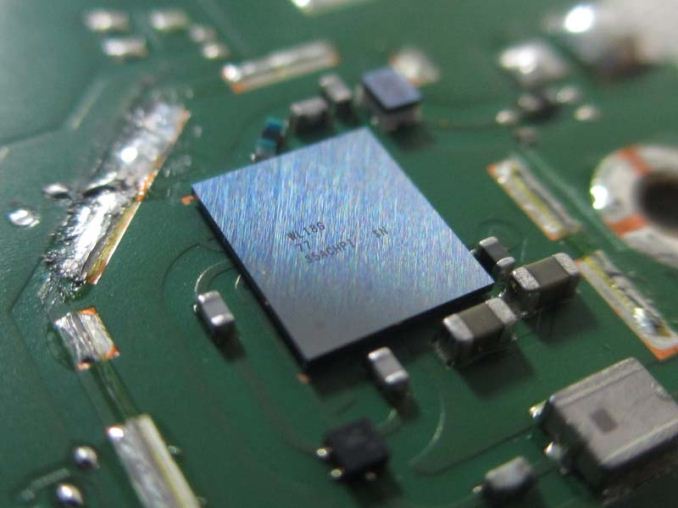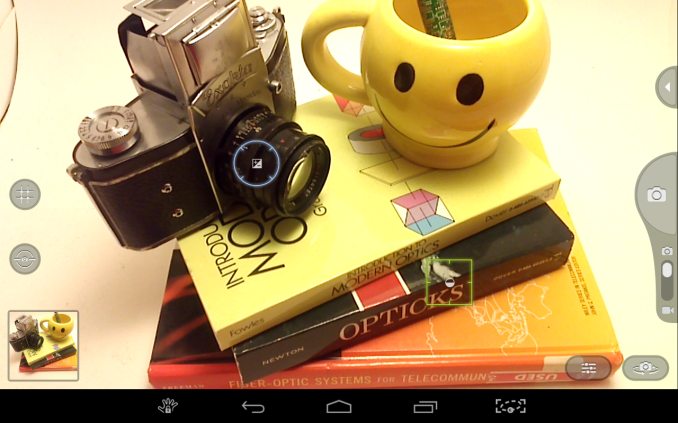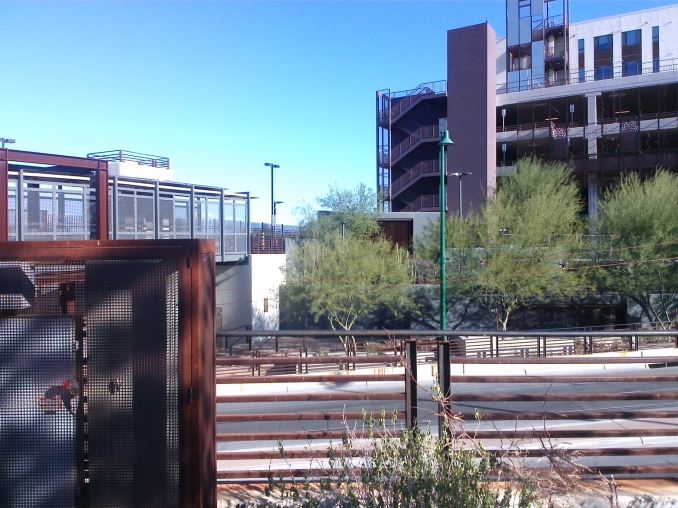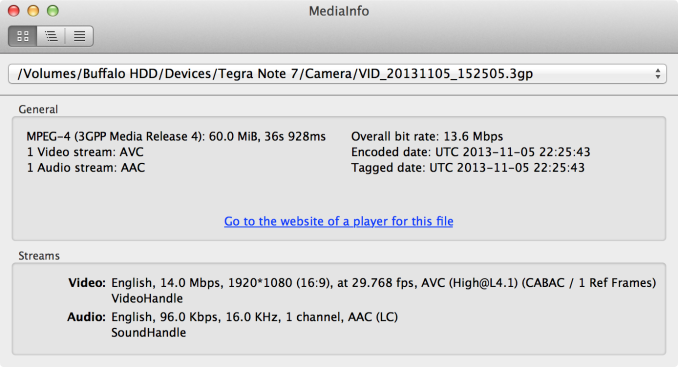NVIDIA Tegra Note 7 Review
by Brian Klug on November 12, 2013 9:01 AM EST- Posted in
- Tablets
- Mobile
- Tegra 4
- NVIDIA
- Tegra Note
WiFi, Camera, Speaker
WiFi
WiFi onboard Tegra Note is courtesy a TI Wilink 8 (WL18xx) series combo which also powers Bluetooth 4.0/LE. I keep hearing that TI has exited the mobile space completely, the reality is that TI continues to have a combo business and makes the PMICs for NVIDIA’s Tegra 4 SoC lineup. In addition the Tegra Note uses a TI GNSS (GPS and GLONASS).
Anyhow Tegra Note includes single stream 2.4 GHz WiFi, 802.11b/g/n, Miracast, and Bluetooth 4.0/LE. I’d love to see 5 GHz be a baseline, but that’s still not the case here, and also has the side effect of making the Tegra Tab incompatible with GameStream.

Throughput on iPerf in our test isn’t bad however among the 2.4 GHz only tests.
Camera
Cameras onboard Tegra Note are 5 MP on the rear, VGA on the front. The rear facing camera CMOS is an OV5690, which is a 1/4“ sensor with 1.4µm pixels, and the front facing camera CMOS is an OV7695 1/13” sensor with 1.75µm pixels. The rear facing camera is F/2.0 with a 4.0 mm focal length according to EXIF, although I’m not sure if I actually believe it, as the field of view looks a lot wider than I’d expect.
Regardless the Tegra Note is our first chance to see Tegra 4’s ISP and something else new, Camera Awesome for Android which is launching with Tegra Note 7. I’ve been complaining about the stock Android camera application for a while, which thankfully the Note 7 doesn’t include. Instead the default camera application is Camera Awesome, whose UI implements a number of the Chimera camera architecture features like tap to track, full resolution burst capture, and in a future release, always-on HDR.
Unfortunately the UI makes the same critical mistake that I see in the stock Android camera, and presents a 16:9 aspect crop of the 4:3 image formed on the sensor. The result is that images have more visible area above and below the preview area shown in the camera application.
Still image quality is actually a lot better than I expected it to be, but looks like a smartphone camera from a year or two ago. It’s adequate enough for a tablet but wouldn’t be competitive in the smartphone space, a few images are a bit hazy as well. I made sure to wipe the cover glass atop the camera between shots, but it’s possible this still contributed to the hazy appearance of a few of the sample shots. Tablets just need to have a camera these days, I’d argue that the one in Tegra Note gets the job done well enough.
Video on the rear facing camera is 1080p30, H.264 High profile with 1 reference frame, at 14 Mbps. I’ve uploaded the video to YouTube for quick viewing and to our servers if you want to see it without a transcode. Oddly enough the file format is .3gp, something I haven’t seen in quite a while. Video has an overexposed appearance and exposure distractingly hunts around quickly quite a lot even in the 40 seconds at the bench location, AF also runs quite a bit. I’m a bit disappointed in overall video quality and hope it improves dramatically with the December update. You can check off the box for video recording on Tegra Note, but not much beyond that.
Speaker
Since the HTC One, front facing speakers are starting to be a regular affair. The Nexus 7 (2013) shipped with stereo speakers, but they fire out the back. I measured the Tegra Note 7 using two songs that I’ve used for comparisons before and the sound data logger I’ve always used. I expected the Tegra Note to come out on top just because of the front facing speakers, oddly enough in terms of loudness the Nexus 7 was slightly ahead, although I suspect the A weighting I’ve always used might give it an edge.
| Speaker Loudness Comparison | ||||
| ASUS Nexus 7 (2013) | EVGA Tegra Note 7 | |||
|
Don't Move (dBA) |
82.11 | 81.92 | ||
|
Feel It All Around (dBA) |
83.44 | 82.90 | ||
The reality is that sound pressure level isn’t everything, it’s absolutely true that the Tegra Note has much more dynamic mids and lows than the Nexus 7 which sounds tinny in comparison. I'd subjectively say that the Tegra Note sounds way better, but is slightly quieter. The Nexus 7 is louder, but it's mostly high frequencies and much more tinny sounding. Tegra Note has speaker protection which runs on the Tegra 4 SoC as opposed to onboard a DSP inside a discrete component or elsewhere like I’ve seen for other products.




















87 Comments
View All Comments
Morawka - Tuesday, November 12, 2013 - link
arent those yoga 2's $1500ddriver - Tuesday, November 12, 2013 - link
And if you are really serious - use pen and paper. And if the environmental impact is a major factor - scan, ocr and recycle the paper ;)Nothing beats pen and paper, and especially not a glossy screen. It is mighty inconvenient to use a stylus on a glossy surface, it is just too damn slippery and does not have the nice grip of paper. I am looking to get some kind of a matte screen protector for my note 3, the pen feels much, much better on a matte surface, tested on my dell monitor, much more grip and much better control over the tip.
zodiacsoulmate - Tuesday, November 12, 2013 - link
I use surface pro and it completely replaced paper(even math assignments). when i print the solution out, it looks the same as i wrote it on paper but cleaner.Krysto - Tuesday, November 12, 2013 - link
What's wrong with the Note? Surface Pro also comes twice as much, and feels twice as heavy. That being said, I'd rather wait for Galaxy Note 12.2 if I was an artist.frostyfiredude - Tuesday, November 12, 2013 - link
I've got a Pro 2. Couple things I can think of for getting a Surface Pro(2) over a Note:-I've yet to see a program that handles notes as well as OneNote does. The syncing, cross platform support, pressure sensitivity, drawing tools and little things like the print driver together are awesome.
-Slightly bigger screen makes notes more comfortable, I find the Pro 2 to be barely big enough so even being 10% or so smaller the Note 10.1 will feel notably less comfortable to work with.
-Looking at videos online, palm rejection is clearly better implemented with the Surface (Microsoft nailed this). This is a big deal for making the note taking process feel comfortable and natural.
An artist has even more reason to go Pro, with all the powerful tools like Adobe CS, Corel's painting programs and their add ons. Android's tools are a massive compromise in comparison, the couple artists I know have been less than satisfied with their run-ins with the Android options thus far.
fbales - Sunday, December 1, 2013 - link
Disagree. Sorry, but for less than 200 bucks it is not hands down for a Surface Pro 2. Not saying it's not a better tablet, what I'm saying this Tegra Note 7 is pretty hard to beat for the price. And don't be put off by the screen resolution. It's the same as the first Nexus 7 which reviewers raved about. Certainly not the best, but still very good.GrzegorzWidla - Tuesday, November 12, 2013 - link
If stylus works that well, it baffles me why Microsoft has not brought that tech to Surface 2 RT.That would be a killer feature at half of Surface 2 Pro price. In fact, if Surface 2 had a active digitizer (or alternative technology that works well), I wouldn't need Pro at all.
BoneAT - Tuesday, November 12, 2013 - link
Performance and price point is nice, but everything else is underwhelming, especially the screen.I hoped for the Nexus 5 review haha, but I guess y'all waiting for tomorrow's update?
Wade_Jensen - Tuesday, November 12, 2013 - link
Has Brian lost his nexus 5 or something? I'm starting to think it must benchmark boost to keep him quiet that long.ISwearImCool - Saturday, November 16, 2013 - link
Or maybe, he really likes it. The HTC One review took like a month. He puts more time into things he likes. Compare HTC One vs S4